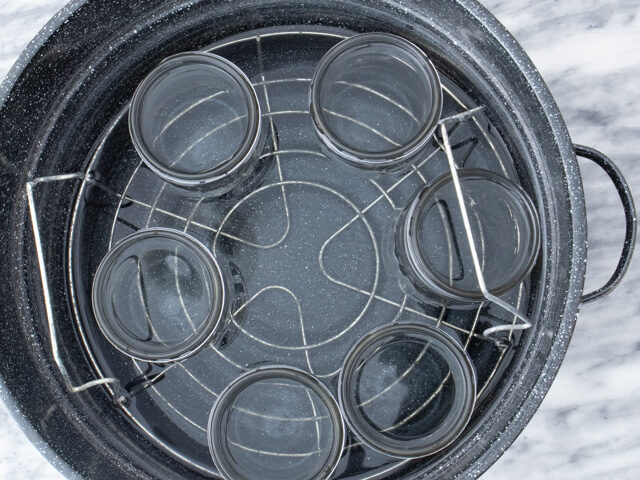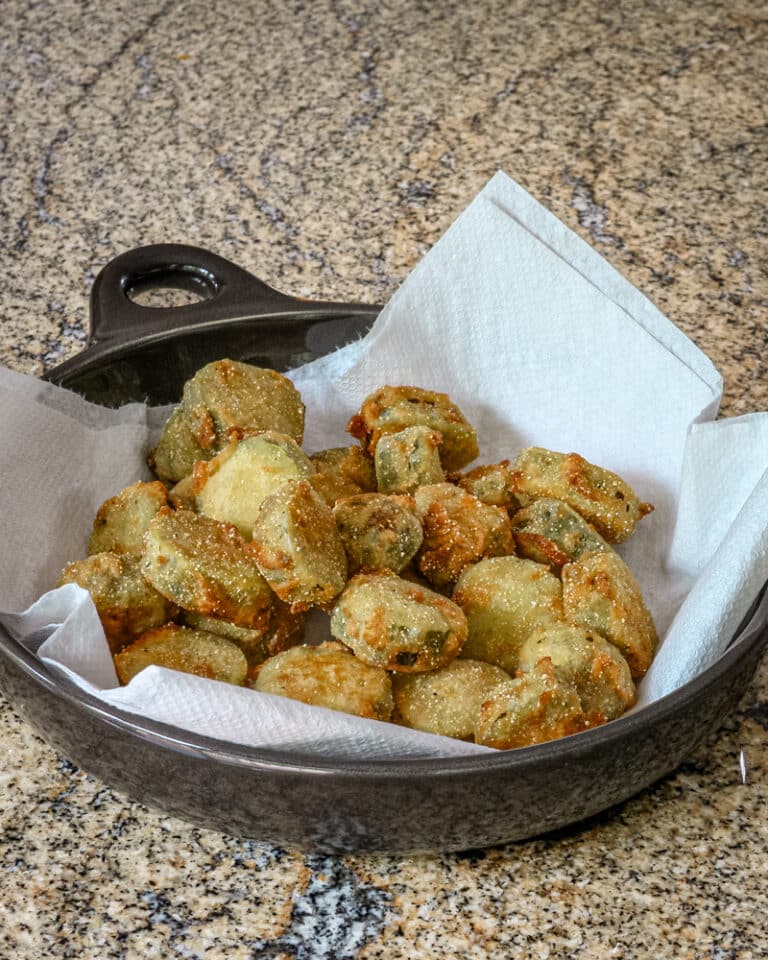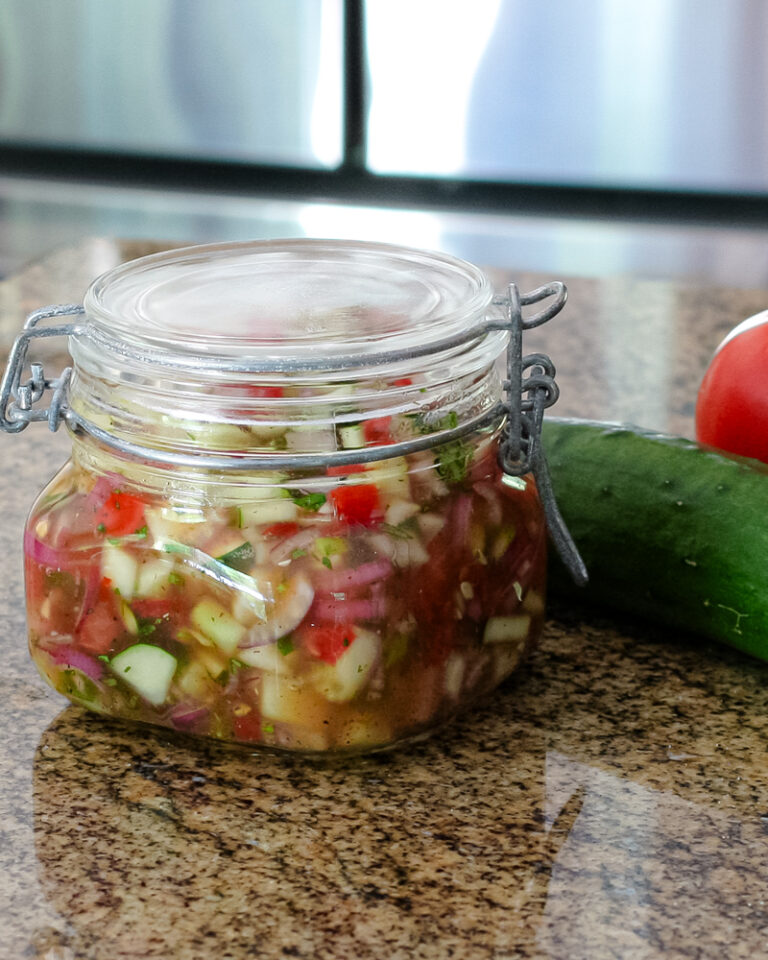Sweet and Spicy Corn Relish
Spice up your meals with homemade sweet and spicy corn relish. It’s a versatile condiment that pairs well with chicken, pork, fish, and more!

This sweet-and-spicy corn relish is a great way to preserve summer vegetables. The combination of sweet onions, peppers, cucumbers, and corn gets its flavor from a sweet-and-sour brine. For hot peppers, I like to use jalapeño or Fresno peppers. For less heat, you might like banana peppers or Anaheim.
Whether spooned over grilled meats, spread on crostini, or served on a charcuterie board, this relish adds a burst of flavor and texture to nearly any dish. It’s easy to can using a simple water bath method, and the canned relish can be enjoyed for months.
What You’ll Like About This Recipe
- Straightforward canning method. The water bath process is simple and reliable, making this a good recipe for beginners or anyone wanting a low-effort canning project.
- Flexible heat level. The combination of sweet onions, bell peppers, and hot peppers gives the relish depth without overwhelming spice. You can increase or reduce the hot peppers depending on your preference.
- Balanced flavor. Apple cider vinegar and sugar create a brine that’s sweet, tangy, and mild enough to pair with many dishes. Dry mustard, turmeric, and celery seeds add gentle background flavor.
- Good texture. Processing the vegetables in the food processor ensures small, even pieces that hold up well in the brine and make the relish easy to spoon.
- Useful across many meals. This relish works as a topping, side condiment, or mix-in and keeps well on the pantry shelf once processed.
Ingredient Notes
- Sweet onions – Their mild flavor pairs well with the vinegar brine. Use yellow or sweet varieties for the best balance.
- Bell peppers – Red and green peppers offer color variation and a mild sweetness. Remove seeds and membranes before processing.
- Hot peppers – Choose the variety that matches your desired heat level. Jalapeños or serranos work well; remove seeds if you want a milder result.
- Corn kernels – Fresh corn adds the best texture, but frozen corn is a convenient substitute and holds its shape during simmering.
- Cucumber – Adds moisture and a small amount of crunch. Peel or leave the skin on based on your preference.
- Apple cider vinegar – Provides acidity and a slight fruitiness. Use 5% acidity vinegar for safe canning.
- Sugar and salt – Create the sweet-salty balance of the brine. Canning salt dissolves cleanly without clouding the liquid.
- Dry mustard, celery seeds, turmeric – Mild seasonings that add color and depth without overpowering the vegetables.
Steps to Make Sweet and Spicy Corn Relish
- Heat your canning kettle with jars inside so they stay hot and ready for filling. Keeping the jars warm prevents cracking when the hot relish is added.
- Pulse the onions, bell peppers, and hot peppers in a food processor until finely chopped. The small pieces help the relish pack evenly into jars.
- Combine the processed vegetables with the corn, vinegar, sugar, salt, dry mustard, celery seeds, and turmeric in a large pot. Bring to a boil, then reduce the heat and simmer until the flavors blend.
- Fill the hot jars with the simmering relish, leaving headspace to allow for proper sealing. Wipe the rims clean and apply lids and bands.
- Process the jars in a boiling water bath for the recommended time. Allow the jars to cool undisturbed and check for proper seals before storing.
- Label, store in a cool place, and use as needed for meals throughout the year.
Tips for Corn Relish
- Use fresh corn when in season for the best flavor, or substitute thawed frozen corn.
- Pulse vegetables in batches for even chopping and better texture.
- Use a jar lifter to safely lower and lift jars from boiling water.
- Label jars with date and contents before storing.
Recipe Variations
- Sweeter version. Add a bit more sugar or reduce the hot peppers for a milder profile.
- Spicier version. Include hotter peppers such as habaneros or increase the quantity of jalapeños.
- Herb variation. Add a small amount of dried thyme or dill for a subtle herbal note.
- Corn-and-zucchini relish. Replace some of the cucumber with finely chopped zucchini for added color and texture.
- Smoky version. Add a pinch of smoked paprika to the brine before simmering.
Serving Suggestions
- Serve over grilled chicken, pork chops, or fish like salmon or tuna.
- Add to burgers, turkey burgers, veggie burgers, or hot dogs.
- Use as a taco or burrito topping for sweet-heat flavor and texture.
- Upgrade grilled cheese, sandwiches, or wraps with a spoonful of relish.
- Include in appetizer spreads with cheese, cured meats, and crackers.
- Spread on crostini or bruschetta for a colorful snack.
How to Store and Reheat
Refrigerate: Store opened or unsealed jars in the refrigerator and use within 3 weeks.
Shelf storage: Properly sealed jars can be stored in a cool, dark pantry for up to 1 year.
To use: Spoon directly from the jar—no reheating needed. Serve cold or at room temperature.
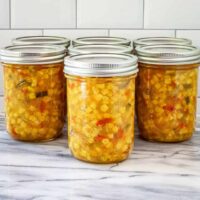
Sweet and Spicy Corn Relish
Ingredients
- 2 pounds sweet onions, coarsely chopped
- 2 cups bell peppers, red and green, coarsely chopped
- 1 cup hot peppers, coarsely chopped
- 8 cups corn kernels, fresh or frozen
- 2 cups cucumber, diced
- 3 cups apple cider vinegar
- 1 1/2 cups granulated sugar
- 1 tablespoon canning salt , or kosher salt
- 2 teaspoons dry mustard
- 1 teaspoon celery seeds
- 1 teaspoon ground turmeric
Instructions
- Prepare the Water Bath: Place a large canning kettle full of water over high heat. Add 7 clean 1-pint canning jars. There's no need to sterilize the jars, but they should be hot when you fill them.
- Process: Transfer the coarsely chopped onions, bell peppers, and hot peppers to a food processor. Pulse until finely chopped.
- Simmer: Combine the processed vegetables, corn, vinegar, sugar, salt, mustard, celery seed, and turmeric in a large stainless steel pot or enamel-lined Dutch oven. Bring to a boil over medium-high heat, then reduce the heat to low and simmer for 15 minutes.
- Fill the Jars: Spoon the relish into the hot jars, leaving 1/2-inch headspace. Wipe rims and jar threads with a damp towel. Fit the jars with the lids. Screw the bands on the jars just to fingertip tightness.
- Process in Water Bath: Place the filled jars on a rack in the canning kettle and lower them into the water. If the water level isn't at least 1 inch above the jars, add more very hot or simmering water to the pot. Bring back to the boil, cover the pan, and boil gently for 15 minutes.* Remove the jars to a rack to cool. If a jar doesn't seal properly, refrigerate it and use it before the others. Store the sealed relish in a cool, dark place.
- Serve: Serve alongside a meal, as a topping, or as an appetizer spread. Enjoy!
Notes
- For altitudes from 1,001 to 6,000 feet, process the jars in the boiling water bath for 20 minutes.
- For altitudes above 6,000 feet, for 20 minutes. For altitudes above 6,000 feet, process the jars for 25 minutes.
Nutrition
Disclaimer:
Our nutritional information is based on a third-party application that analyzes the ingredients list to determine the values. The information is meant to be helpful, but should be considered an estimate. Values may differ depending on measurements, brands, serving variations, and database availability.
